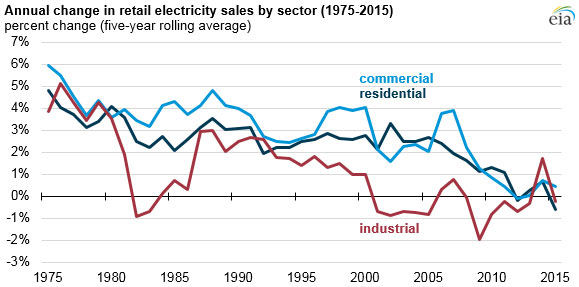EIA: Demand trends drive recent electric generation capacity additions
Published by Angharad Lock,
Digital Assistant Editor
World Coal,
According to the US Energy Information Administration (EIA), the combination of slower electricity demand growth and policies that encourage renewables-sourced electricity generation is changing the type and the amount of generating capacity added each year.
Capacity additions since 2000 are being made under market conditions that differ significantly from those that existed for much of the 20th century.

Source: EIA.
On a net basis, the US added an average of 18.3 gigawatts of additional capacity each year from 1950 to 2015. Two time periods of above-average additions occurred during the oil price crisis of the 1970s and the natural gas-fired capacity buildout of the early 2000s.
As electricity demand growth slowed, new capacity additions also slowed. Lately, new capacity additions often compete with existing generators. The increase in renewable energy sources has also affected the amount of new capacity.
In general, renewable sources tend to have lower capacity factors than dispatchable generation technologies fueled by coal, natural gas, oil, or nuclear energy. Capacity factors reflect a generator's output compared with its capacity, and they reflect how often a generator is actually used. This calculation is important when considering different types of new capacity. For instance, over the course of a year, a 10 MW generator operating at 20% capacity will provide about the same amount of electricity as a 3 MW generator operating at 67%.

Source: EIA.
In regions of the country with competitive wholesale power markets, slower demand growth, high levels of renewable generation capacity additions, and low natural gas prices tend to lower the wholesale prices available to traditional baseload generation technologies, such as coal-fired and nuclear power plants. In some instances, especially in regions of the country with significant amounts of wind generation, electricity prices may be low or even negative during off-peak periods because wind has no fuel cost, and wind generator owners receive tax credits for each kilowatthour of electricity sold. These factors make it profitable for wind generators to bid their units into the market at extremely low or even negative prices to ensure that they are selected for dispatch.

Source: EIA.
With increasing amounts of surplus generation, the EIA press release continued, competitively determined capacity payments in regions that have instituted capacity auctions may be reduced. Operators of some existing coal and nuclear power plants face growing challenges in covering their fixed costs, a situation that is exacerbated when their plants require new investment under such circumstances in order to continue operation.
Edited from press release by Angharad Lock
Read the article online at: https://www.worldcoal.com/coal/18032016/eia-demand-trends-drive-recent-electric-generation-capacity-additions-2805/
You might also like
EIA reduces its forecast for US coal exports following Port of Baltimore closure
The US EIA has decreased its forecast for US coal exports following the collapse of the Francis Scott Key Bridge and the resulting closure of the Port of Baltimore.

